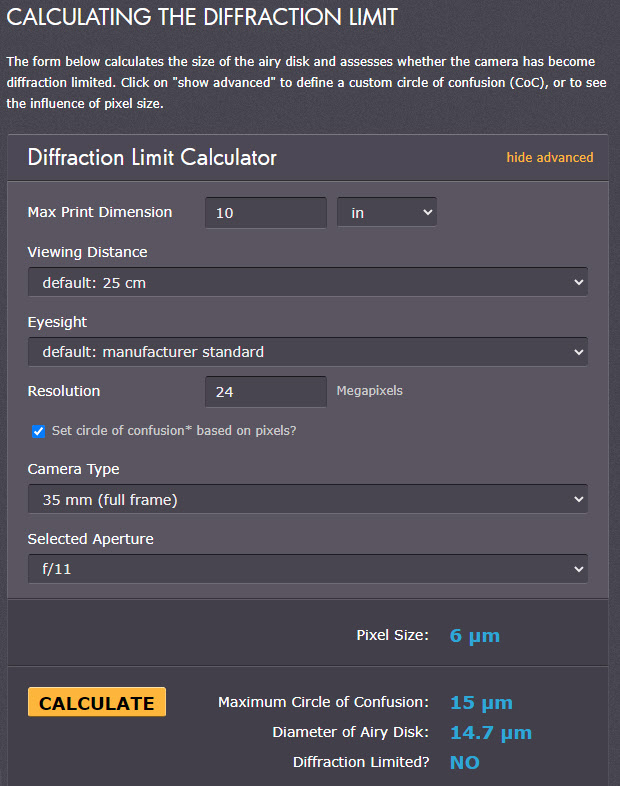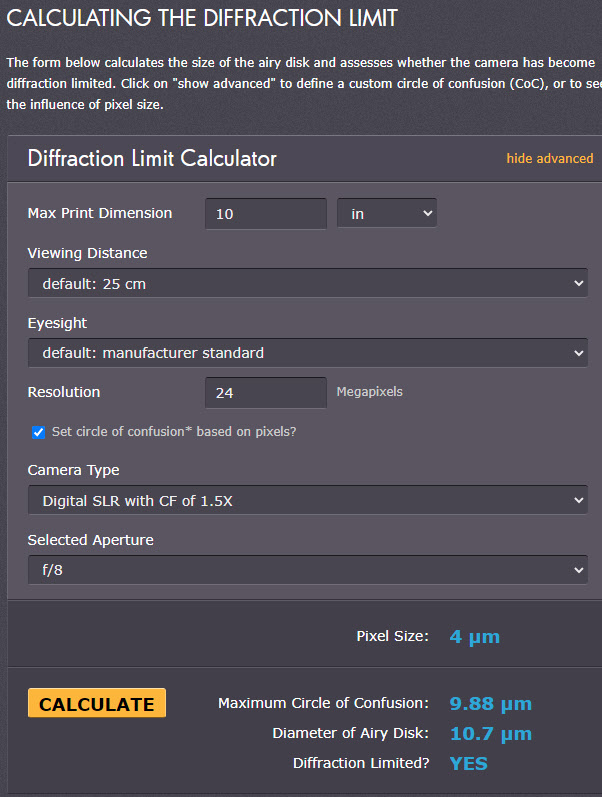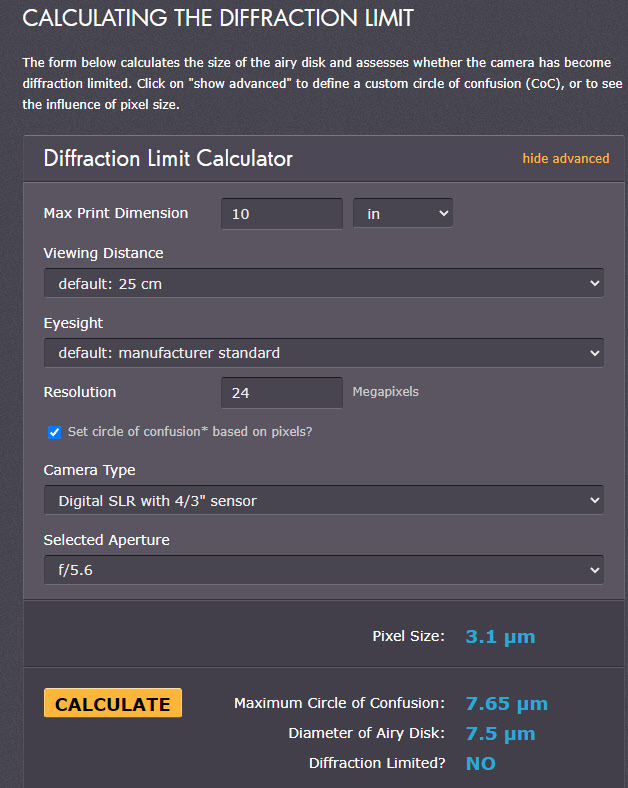Diffraction
Jul 15, 2022 18:26:40 #
Joexx wrote:
With all due respect,diffraction is not worse for ... (show quote)
I ain't no physicist but this seems to make a lot of sense to me. Thank you for explaining.
Jul 15, 2022 19:00:01 #
Joexx wrote:
I still disagree. FOV has nothing to do with diffr... (show quote)
Please see my earlier comment. Of course we all agree how diffraction is created, but the actual mechanism which causes diffraction effects in photography is multiple pixels being covered by the Airy disc, and the smaller the pixels, the more likely that multiple pixels will be covered. For equivalent resolution, smaller sensors have smaller pixels, hence more pixels covered by the same size Airy disc and greater diffraction effects. The article I referenced from Cambridge in Color explains it in simple terms and includes a calculator that demonstrates what I said above. Please read that article and tell me why you disagree.
Jul 15, 2022 20:44:38 #
TriX wrote:
Please see my earlier comment. Of course we all ag... (show quote)
Sorry, but respectfully, you are incorrect. Several things you mentioned are inconsistent. You say "For equivalent resolution, smaller sensors have smaller pixels". But resolution is reflected by the number of pixels per area. So smaller sensors, of the same resolution, will by definition have exactly the same number of pixels as a larger sensor. I did read the link you suggested. A very good article. But it id mostly discussing resolution issues that we are no. Here is a quote from that link. "Diffraction thus sets a fundamental resolution limit that is independent of the number of megapixels, or the size of the film format. It depends only on the f-number of your lens, and on the wavelength of light being imaged". Of course if you have a higher resolution sensor (higher pixel density) it will be more sensitive to a smaller diffraction than a lower resolution sensor (lower density). But this has nothing to do with the amount of diffraction that is caused by the aperture opening. (see the quote from your link). Yes, there are issues with smaller pixels, but that is not what the question or discussion was about. Another example would be to take a FF camera that also has a setting to use it as a crop sensor camera. If you compare two photos. One shot FF & one shot crop. They will have IDENTICAL diffraction regardless of what lens opening you choose. I think we are discussing two different issues. I do appreciate your comments. Thanks
Jul 15, 2022 20:45:03 #
Joexx wrote:
I still disagree. FOV has nothing to do with diffr... (show quote)
Yes, we still DISAGREE

 your mind seems very constricted on this.....
your mind seems very constricted on this.....Jul 15, 2022 21:07:04 #
imagemeister wrote:
Yes, we still DISAGREE 
 your mind seems very constricted on this.....
your mind seems very constricted on this.....

 your mind seems very constricted on this.....
your mind seems very constricted on this.....If you think I am wrong, it is useful if you tell me specifically which sentence I typed is incorrect. It is not useful to insult me. Since all you did is insult me, it seems to indicate that you have no idea why you think I am wrong. I am perfectly fine with discussing a question on facts, and perhaps I will be wrong & I will learn something but it is a waste of my time to trade insults. Your response will tell me which you enjoy more.
Jul 15, 2022 21:21:48 #
Joexx wrote:
Sorry, but respectfully, you are incorrect. Severa... (show quote)
When I used the term resolution, I was referring to the total number of pixels on the sensor - what term would you use? Of course, ONE definition of resolution is pixels or lines or… per area, but I hope you would agree that a 30MP image is higher resolution than a 15MP one. Perhaps I should have used the term pixel size or pitch instead, but I’m fairly sure you understood that the point was that everything else being equal, pixels on smaller format cameras are smaller than larger format cameras.
The original question was whether diffraction is a PRACTICAL consideration or just a theoretical construct, and the answer is the former if obtaining the maximum sharpness from your lens/body combination is important to you. And since the original question concerned practical applications, regardless of the formula used to calculate it, the fact is that for equivalent “total resolution” (substitute whatever term you like here, but I’m referring to the total number of pixels on the sensor), visible/measurable diffraction occurs at a larger aperture on smaller format sensors than larger format sensors. There IS a difference, and my hope is that you would agree with that - it’s certainly a well known phenomena by professional photographers. Anyone who knows the formula for calculating optical diffraction understands that there is no term for sensor size in the equation, BUT when the Airy disc is projected onto real pixels, there is a PRACTICAL difference between the effect on different density sensors. One can’t examine just one part of a system (the lens) and expect to properly predict the performance of the complete system (lens and sensor).
Jul 15, 2022 21:38:40 #
TriX wrote:
Here’s the practical difference from a real lens t... (show quote)
The difference between the lowest and highest values on this chart is just under 10%. In my opinion sharpening in post could easily make up that difference. Variation due to the quality of light would be more significant...so I wouldn't hesitate to use the entire aperture range when appropriate.
Jul 15, 2022 21:47:51 #
Joexx wrote:
If you think I am wrong, it is useful if you tell me specifically which sentence I typed is incorrect. It is not useful to insult me. Since all you did is insult me, it seems to indicate that you have no idea why you think I am wrong. I am perfectly fine with discussing a question on facts, and perhaps I will be wrong & I will learn something but it is a waste of my time to trade insults. Your response will tell me which you enjoy more.
I am not going to write a book trying to teach you something ( no insult)- I am not here to argue ! I have explained myself quite WELL - I suggest you re-read my comments CAREFULLY and THINK about it. You are not completely wrong but not completely right either. Sooo, we DISAGREE ! Live with it !
Jul 15, 2022 22:09:25 #
joer wrote:
The difference between the lowest and highest values on this chart is just under 10%. In my opinion sharpening in post could easily make up that difference. Variation due to the quality of light would be more significant...so I wouldn't hesitate to use the entire aperture range when appropriate.
A valid opinion. And if a 10% difference in sharpness is inconsequential and everything can be fixed in post, then might as well save some big $ and go with mediocre glass as well

Jul 16, 2022 07:25:54 #
Urnst wrote:
We have all heard that small lens apertures cause diffraction, which degrades images. What does that really mean in practice? How much difference does it really make?
https://www.uglyhedgehog.com/t-645702-1.html
Jul 16, 2022 11:05:57 #
Urnst wrote:
We have all heard that small lens apertures cause diffraction, which degrades images. What does that really mean in practice? How much difference does it really make?
Depends on whether the angels will be dancing, and acoarst the style of dance. Dance requires much more space than crowding together shoulder to shoulder on the pinhead.
Jul 17, 2022 01:07:52 #
CHG_CANON wrote:
The best way to detect / disprove diffraction for ... (show quote)
Nice easily understood and concise explanation of the issue.
Thanks
Jul 17, 2022 09:45:25 #
Joexx wrote:
The size of the sensor does not change the amount of diffraction. I.E. FF or crop.
It does.
You have to magnify a cropped image more than a full frame image. When you do that you also magnify the airy disk. That makes the diffraction easier to see.
Full frame at f/11

APSC 1.5x at f/8

Micro 4/3 at f/5.6

Jul 17, 2022 10:21:50 #
Joexx wrote:
With all due respect,diffraction is not worse for M4/3 than a FF. I think everyone is misunderstanding what diffraction is. ...
It seems like almost everyone else understands it.
Jul 17, 2022 13:02:18 #
selmslie wrote:
It does.
You have to magnify a cropped image more than a full frame image. When you do that you also magnify the airy disk. That makes the diffraction easier to see.
You have to magnify a cropped image more than a full frame image. When you do that you also magnify the airy disk. That makes the diffraction easier to see.
This is yet another INDIRECT way the sensor size affects the final product ! ....
If you want to reply, then register here. Registration is free and your account is created instantly, so you can post right away.




